Power generation from infrared light

Researchers at Rice University, who detailed their findings in the journal Science, hoped the technique would be used in new instruments for infrared-light detection and for higher-efficiency solar cells.
“We’re merging the optics of nanoscale antennas with the electronics of semiconductors,” said lead researcher Naomi Halas, a professor in electrical and computer engineering.
“There’s no practical way to directly detect infrared light with silicon, but we’ve shown that it is possible if you marry the semiconductor to a nanoantenna. “We expect this technique will be used in new scientific instruments for infrared-light detection and for higher-efficiency solar cells,” she said.
More than a third of the solar energy on the earth arrives in the form of infrared light. But silicon—the material used to convert sunlight into electricity in majority of today’s solar panels—cannot capture infrared light’s energy.
According to scientists, every semiconductor, including silicon, has a “bandgap” where light below a certain frequency passes directly through the material and is unable to generate an electrical current.
By attaching a metal nanoantenna to the silicon, where the tiny antenna is specially tuned to interact with infrared light, the Rice team showed they could extend the frequency range for electricity generation into the infrared.
When infrared light hit the antenna, it created a “plasmon”, a wave of energy that sloshes through the antenna’s ocean of free electrons.
It has been known that plasmons decay and give up their energy in two ways; they either emit a photon of light or they convert the light energy into heat. The heating process begins when the plasmon transfers its energy to a single electron—a ‘hot’ electron.
Rice graduate student Mark Knight, lead author of the paper, together with Halas and colleagues set out to design an experiment to directly detect the hot electrons resulting from plasmon decay.
Patterning a metallic nanoantenna directly onto a semiconductor to create a “schottky barrier”, the researchers found that the infrared light striking the antenna resulted in a hot electron that could jump the barrier, which created an electrical current. This works for infrared light at frequencies that would otherwise pass directly through the device.
A Schottky barrier, named after Walter Schottky, is a potential barrier formed at a metal–semiconductor junction with rectifying characteristics suitable for use as a diode.
Knight said: “The nanoantenna-diodes we created to detect plasmon-generated hot electrons are already pretty good at harvesting infrared light and turning it directly into electricity.
“We are eager to see whether this expansion of light-harvesting to infrared frequencies will directly result in higher-efficiency solar cells.”
Deccan Herald is on WhatsApp Channels| Join now for Breaking News & Editor's Picks